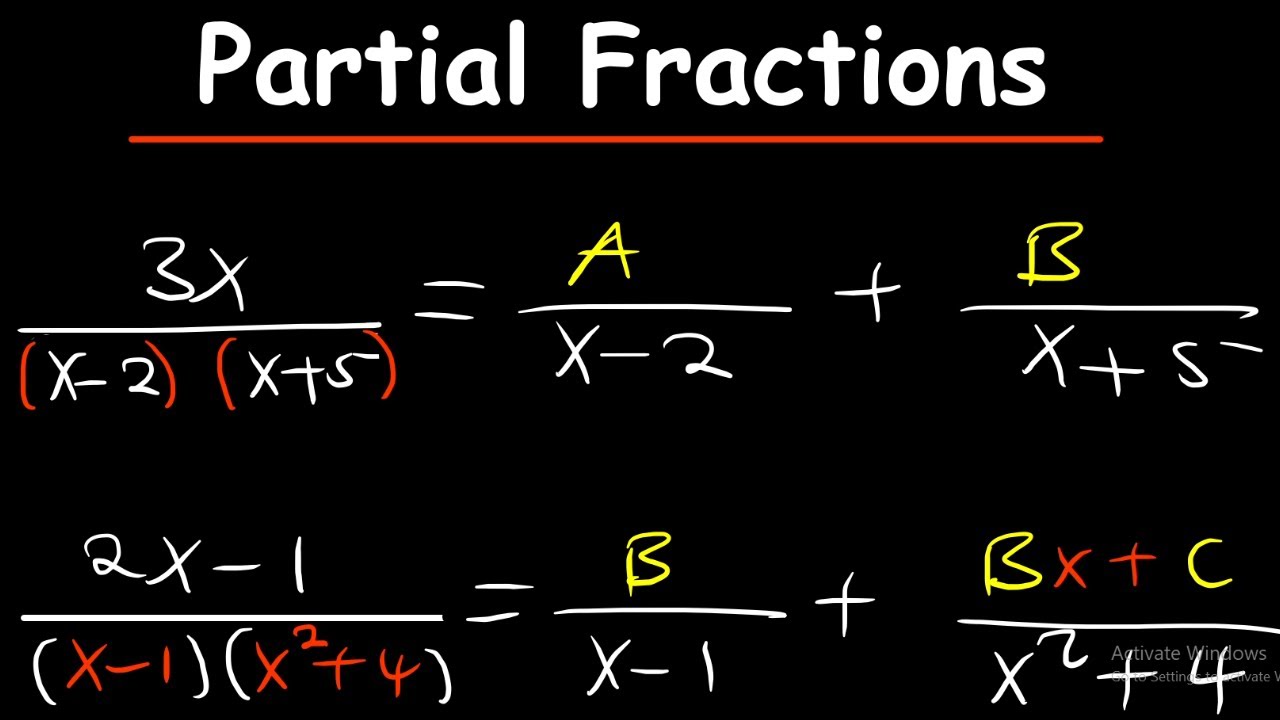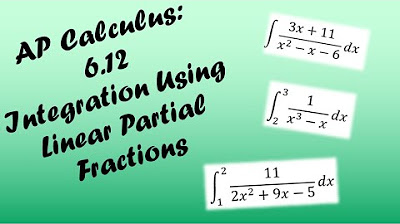how to setup partial fractions (all cases)
TLDRThis educational video script delves into the concept of partial fractions, a technique used in calculus for integrating rational functions. It clarifies why, when dealing with a fraction that has a repeating factor in the denominator, it's necessary to include all powers of that factor, starting from the first. The script outlines the setup for partial fractions, emphasizing the importance of ensuring the degree of the numerator is less than the degree of the denominator. It also explains how to handle irreducible quadratics and provides a strategy for setting up and solving for constants in partial fraction decomposition. The video aims to demystify the 'biggest why' in partial fractions, using substitution to simplify complex expressions and offering a clear, step-by-step approach to mastering the topic.
Takeaways
- 📚 Partial fractions are used to decompose complex rational expressions into simpler fractions.
- 🔍 The degree of the numerator must always be less than the degree of the denominator in a partial fraction setup.
- 📉 When dealing with a repeating linear factor, such as (x + 2)^2, both the first power and the squared power need to be included in the setup.
- 📝 For irreducible quadratic factors, the setup involves a linear term on the numerator and a constant on the top for the corresponding fraction.
- 🔑 The general form for a partial fraction with a quadratic factor includes a linear term on the numerator (bx + c).
- 📈 The 'build up the power' method is used to systematically set up the numerators for repeated factors, starting from the first power and incrementing by one.
- 🧩 It's possible to split fractions with single-term denominators into separate fractions for easier decomposition.
- 🔄 The process of substitution, such as setting t = x + 2, can simplify complex expressions and help in setting up partial fractions.
- 🔍 The top of the fraction in a partial fraction decomposition can be constants or linear terms, depending on the degree of the denominator.
- 📐 The method of partial fractions is not just about the numbers but also about the form of the expression, which is crucial for the setup.
- 🔑 To solve for the constants in a partial fraction decomposition, techniques like the 'kapha method' can be used, as mentioned for a future video.
Q & A
What is the main topic of the video script?
-The main topic of the video script is explaining the concept of partial fractions, particularly when dealing with repeating factors in the denominator.
Why is the degree of the numerator less than the degree of the denominator when setting up partial fractions?
-The degree of the numerator must be less than the degree of the denominator to ensure that the fraction can be decomposed into simpler fractions that can be easily integrated or simplified.
What does the term 'repeating factor' refer to in the context of partial fractions?
-A 'repeating factor' refers to a factor in the denominator that appears more than once, such as (x + 2)^2, which requires a different approach in setting up the partial fractions.
What is the general form of the setup for partial fractions when dealing with linear factors?
-The general form for partial fractions with linear factors is to have constants (A and B) as the numerators over each linear factor in the denominator, ensuring the degree of the numerator is one less than the degree of the denominator.
How does the setup change when there is an irreducible quadratic in the denominator?
-When there is an irreducible quadratic in the denominator, the setup involves a constant numerator over the quadratic factor for the first fraction, and a linear term (Bx + C) over the quadratic for the second fraction.
What is the 'build up the power' method mentioned in the script?
-The 'build up the power' method refers to starting with the lowest power of x in the denominator and incrementally increasing the power by one for each subsequent term in the partial fraction decomposition, until reaching the highest power present in the original denominator.
Why is it necessary to include both x and x^2 in the setup when dealing with a quadratic denominator like x^2?
-Including both x and x^2 is necessary because x^2 can be seen as x multiplied by itself (x*x), which means that when setting up partial fractions, we need to account for each power of x separately, starting from the first power and building up.
How can we determine the constants A, B, and C in the partial fraction setup?
-The constants A, B, and C can be determined by using methods such as equating coefficients or the Heaviside cover-up method, which involves substituting specific values to solve for these constants.
What is the purpose of the substitution t = x + 2 in the script?
-The substitution t = x + 2 simplifies the expression by transforming it into a form that is easier to work with when setting up partial fractions, especially when dealing with repeating factors.
Can the method of partial fractions be applied to any rational function?
-Partial fractions can be applied to any rational function where the degree of the numerator is less than the degree of the denominator. It is particularly useful for integration and simplification purposes.
Outlines
📚 Understanding Partial Fractions Decomposition
This paragraph delves into the concept of partial fractions, particularly when dealing with a complex fraction that includes a repeating factor in the denominator. The speaker explains the importance of setting up the equation correctly, ensuring the degree of the numerator is less than that of the denominator. The example provided involves a fraction with a quadratic factor in the denominator, which is irreducible and requires a different approach than linear factors. The speaker also introduces the general form for setting up partial fractions, emphasizing the need for constants in the numerator when the denominator is quadratic and explaining how to handle different cases, including irreducible quadratics and linear factors.
🔍 Deep Dive into Repeating Factors and Building Up Powers
In this paragraph, the focus shifts to the intricacies of handling repeating factors in partial fraction decomposition. The speaker illustrates the process of 'building up the power', which involves starting with the first power of x and incrementally increasing the power until it matches the highest power in the denominator. The paragraph provides a step-by-step guide on setting up the fraction, including the substitution of variables to simplify the expression. The use of substitution (e.g., setting t = x + 2) is highlighted as a method to transform the fraction into a more manageable form, allowing for easier decomposition. The speaker concludes by reiterating the importance of correctly identifying and setting up the terms in the numerator to match the powers in the denominator.
Mindmap
Keywords
💡Partial Fractions
💡Repeating Factor
💡Degree
💡Irreducible Quadratic
💡Setup
💡Kapha Method
💡General Form
💡Build Up the Power
💡Substitution
💡Integration
Highlights
Introduction to partial fractions and the importance of degree on the numerator being less than the denominator.
Setup for partial fractions when dealing with linear factors.
Explanation of why the degree on the top must be one less than the degree on the bottom.
Strategy for setting up partial fractions with irreducible quadratic factors.
Dealing with repeating factors in partial fraction decomposition.
The concept of 'build up the power' in setting up partial fractions for higher degree polynomials.
How to handle a quadratic term in the denominator with a linear numerator.
The method of splitting the fraction when the denominator has a single term.
Cancellation technique in partial fractions to simplify the expression.
The necessity of including terms up to the power of the highest degree in the denominator.
The process of substitution to simplify complex partial fraction expressions.
Transformation of the original expression into a simpler form using substitution.
Re-establishing the original variable to match the simplified expression.
The significance of the form over the numbers in setting up partial fractions.
Final expression setup for partial fractions with quadratic and linear terms.
The reason for including each term in the partial fraction setup, even if it seems redundant.
Conclusion and summary of the key points in partial fraction decomposition.
Transcripts
5.0 / 5 (0 votes)
Thanks for rating:





